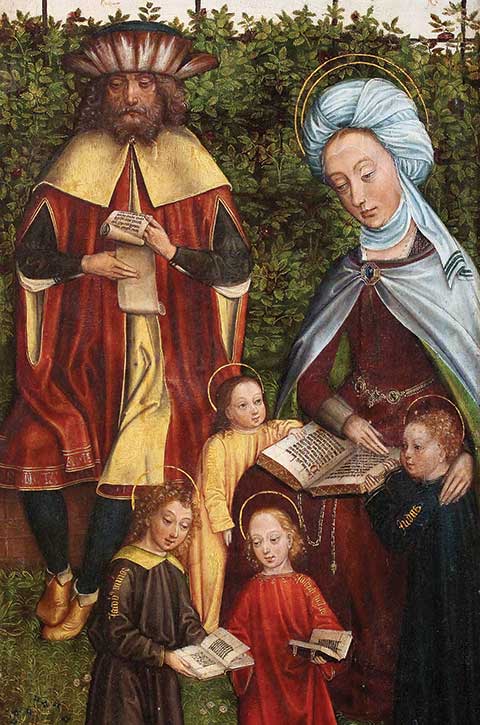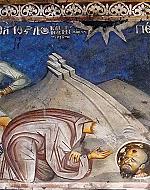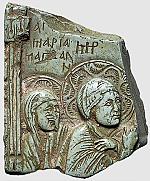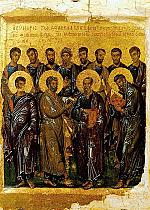Leading the “Way”

[ABOVE: Master of the Family of Saint Anne, Detail from Tryptich of The Family of Saint Anne, 1500 to 1510. Oil on panel. Museum of Fine Arts Ghent—Public domain, Wikimedia]
BARNABAS, ENCOURAGING MISSIONARY
Barnabas means “Son of Encouragement” and was the name given by the apostles to Joseph, a wealthy Levite (Acts 4:36–37) from Salamis, Cyprus. He probably studied in Jerusalem under Gamaliel along with Paul, who later traveled with him on his first missionary journey around 47 to Cyprus and Asia Minor (modern Turkey). Clement of Alexandria lists Barnabas as one of the 72 disciples of Luke 10:1, and Luke calls him an apostle (Acts 14:4, 14). He is the traditional founder of the church in Cyprus.
Tertullian believed Barnabas to be the author of Hebrews, and Clement confirms him as the author of the Epistle of Barnabas (not to be confused with the Gospel of Barnabas written in the sixteenth century). The Epistle describes Old Testament practices as understood from a New Testament perspective and stresses duties toward widows and orphans. The early church valued the Epistle and included it in a fourth-century Bible known as Codex Sinaiticus after Revelation, but never considered the work canonical. Later scholars question his authorship. Conflict with the Jewish community in Salamis resulted in a mob stoning him to death in about 61. John Mark, who witnessed the event, recovered his body and buried it west of Salamis in an old, undisclosed tomb, which was then reportedly discovered in 488. A monastery now marks the location.
JAMES AND JUDE, BROTHERS OF JESUS
The first record of James and Jude occurs in the Gospel of Matthew. Jesus’s mother and brothers try to see him, and he replies that those who do the will of the Father are his family (Matt. 12:46-50). Later, when Jesus speaks in Nazareth, critics note the presence of his family (Matt. 13:55–56). Matthew gives the names of his brothers: James, Joseph, Simon, and Judas. Judas and Judah are variants of Jude (similar to William, Bill, and Billy). Paul later alludes to “the Lord’s brothers [adelphoi]” (1 Cor. 9:5) as having wives.
Three interpretations exist to explain how these “brothers” were actually related to Jesus. The first, favored by most Protestants, is that after Jesus was born, Mary and Joseph had children of their own. These younger brothers did not believe Jesus to be the Messiah until after the Resurrection. Critics of this view question why Jesus would entrust his mother to John if other brothers were available.
The next two explanations hold to Mary’s perpetual virginity. The Coptic and Greek churches believe that Joseph had a prior marriage. With his first wife, he had four sons and two daughters, Jesus’s half-siblings. This would make Joseph considerably older than Mary and more a guardian than a husband. While this arrangement was not unheard of, critics say Scripture gives no hint of it. It would also mean that Jesus was not Joseph’s eldest son or natural heir in the Davidic line.
The last explanation, favored by the Latin West, believes they were cousins. In this view, Mary, the wife of Cleophas (Clopas) or Alphaeus (both names relate to the same person), was the sister of Jesus’s mother, Mary, and Cleophas was Joseph’s brother. This preserves the perpetual virginity of both Mary and Joseph and claims James and Jude as part of the 12 apostles as James the Less and Thaddeus. Critics note this view assumes that both sisters were named Mary, that the brothers were active followers of Jesus prior to the Resurrection, and that this is the most problematic way of interpreting the word for “brothers.”
James is now known as the author of the general epistle that bears his name, but he identifies himself as the servant of Jesus (James 1:1). All descriptions of him are as a pious and holy man, called James the Just. Hegesippus (110–180), a second-century church historian, notes that James prayed in the temple so often for the forgiveness of the Jewish people that “his knees became hard like a camel’s.” He did not believe Jesus was the Messiah (John 7:5) until Jesus appeared to him after the Resurrection (1 Cor. 15:7). James became the leader of the church in Jerusalem following the execution of John’s brother, James. Jewish Christians valued his leadership, and he held the position for some 30 years, presiding over the Jerusalem Council (Acts 15).
Because of his piety, the Sanhedrin brought him to the temple parapet at Passover to have him “persuade the crowd not to err regarding Jesus.” When he affirmed Jesus as the Messiah, the leaders claimed even James was deceived and they threw him over the wall. The fall did not kill him so they stoned him, all while James was praying for their forgiveness. Then one attacker hit James on the head with a club, killing him. While Hegesippus puts this in 69, the Jewish historian, Josephus, writing a generation earlier, has him stoned between the procuratorships of Festus and Albinus about 62.
Jude wrote the canonical letter bearing his name, describing himself as the brother of James and servant of Jesus (Jude 1:1). One tradition pairs Jude with Simon the Zealot in ministry in Persia, a part of the Parthian Empire, where they led a revival and were martyred in 65. Armenians partner Jude with Bartholomew in ministry there, where they were later martyred.
JOHN MARK, GOSPEL WRITER
John Mark was a cousin to Barnabas (Col. 4:10). It was in the home of his mother, Mary, that the church in Jerusalem prayed for Peter’s release (Acts 12:12). Barnabas brought him along on the first missionary journey, but Mark left them (Acts 13:13). When Barnabas wanted to bring him on the second missionary journey, Paul objected so strongly that they parted company (Acts 15:39). Paul and Mark later reconciled (Philem. 24, 2 Tim. 4:11). Mark is also connected with Peter in Rome (1 Pet. 5:13) who considered him his son in the faith. As a result of this connection, Mark penned his Gospel, writing down stories Peter had preached with Peter’s blessing. Mark could also be the unnamed “young man” who escaped naked at Jesus’s arrest (Mark 14:51). Coptic tradition has Mark founding the church in Alexandria, Egypt, and being martyred in 68. In 827 his relics were moved from Egypt to Venice, Italy, where they are housed in the Basilica di San Marco. A separate tradition claims he was the bishop of Apollonia (multiple cities named Apollonia claim this honor). In this tradition Mark was hung upside down with boulders tied to his hands and left to die.
LUKE, JOURNALING DOCTOR
A Gentile physician (Col. 4:14) from Syrian Antioch and a sometime companion of Paul (recorded in the “we” sections of Acts and in Philemon 24), Luke is the author of both the Gospel that bears his name and Acts. The Gospel is the result of his researching the life of Jesus by talking to eyewitnesses. Much of Acts comes from his own personal experience. Luke was with Paul at the end of Acts in 63 and just prior to Paul’s execution in 65 (2 Tim. 4:11). What he did between these events is unknown. He may have traveled with Paul to Spain or to Ephesus. Early reports state he did not marry and died “full of the Holy Spirit” at the age of either 74 or 84 in either Bithynia (modern Turkey) or Boeotia (modern Greece). Jerome (c. 345–420) notes that Luke’s relics, along with Andrew’s, were moved from Greece to the Church of the Apostles in Constantinople in 357 during Emperor Constantius’s reign. In 1204 crusaders took his relics to Padua, Italy, but a rib was returned in 1992.
PAUL, PERSECUTOR-TURNED-MISSIONARY
Paul was born as Saul around the beginning of the first century into a prominent Hellenistic Jewish family. He was a Roman citizen with a good education, and his family sent him to Jerusalem to study law under Gamaliel. The apocryphal Acts of Paul, written about 160, describes Paul as “a man little of stature, thin-haired upon the head, crooked in the legs, of good state of body, with eyebrows joining, and nose somewhat hooked, full of grace: for sometimes he appeared like a man, and sometimes he had the face of an angel.”
A persecutor of the early church, Paul was converted to become a follower of Jesus on his way to Damascus (Acts 9). Opposition to his preaching led to his return to Tarsus. Barnabas later welcomed him to help with the church in Antioch, which sent them on the first missionary journey. It was on this trip that Saul took the name “Paul” possibly because Sergius Paulus, proconsul of Cyprus, was his first convert. Returning from his third missionary journey, Paul was arrested in Jerusalem, jailed in Caesaria Maritima, and ultimately sent to Rome to appeal his case.
Acts ends in 63 during the second year of Paul’s house arrest. Jerome states that after two years in custody, Paul’s case was dismissed. As support he cites 2 Timothy 4:16-17, where Paul refers to this “first defense” and being “delivered from the lion’s mouth.” Early traditions suggest that after Paul was acquitted, he traveled east (perhaps to Ephesus and/or Crete), then west to Spain before a second imprisonment in Rome and execution. Clement of Rome’s letter to Corinth about the year 96 claims that Paul “taught righteousness throughout the whole world” and “reached the limit of the west.” The Muratorian fragment (late second century) has an introduction to Acts that notes the omission of Paul’s trip to Spain. Eusebius also wrote that “rumor has it” that Paul went to Spain.
The dismissal of Paul’s case and his release from custody is quite possible. Josephus recounts a personal story of when he traveled to Rome to secure the release of “certain priests of my acquaintance, and very excellent persons they were, whom on a small and trifling occasion he [Felix] had put into bonds, and sent to Rome to plead their cause before Caesar.” In Rome Josephus met Aliturius, a Jewish actor favored by Nero, who connected him with Nero’s wife, Poppaea. She used her influence to secure the release of these religious leaders. Since Paul was a religious leader, was held by Felix, and was sent to Rome to have his case adjudicated, it is entirely possible that he was released at the same time as Josephus’s priestly friends.
After his release Paul could have traveled to Spain as he intended. Tortosa, Spain, formerly a Roman colony, has a tradition that Paul founded a church there and consecrated Rufus, the son of Simon of Cyrene, as bishop.
The Great Fire in Rome broke out on July 18/19, 64. When suspicion turned to Nero as the fire’s cause, he deflected suspicion to the Christian community and persecution broke out. Paul was rearrested along with Peter. In 65 Paul was beheaded at the Aquae Salviae (now Tre Fontane). He was buried in the Ostian Way where he was first held in house arrest. The site is outside the first-century city walls, close to the Jewish community, and a focal point for the Christian population. The Church of San Paolo alla Regola now sits on the site. Later renovations discovered a marble slab at the spot where Paul was supposed to be buried, with PAVLO APOSTOLO MART (To Paul, apostle and martyr) written on it. CH
By Lloyd A. Harsch
[Christian History originally published this article in Christian History Issue #156 in 2025]
Lloyd A. Harsch is the John T. Westbrook Chair of Church History and director of the Institute for Faith and the Public Square at New Orleans Baptist Theological Seminary.Next articles
Acts of Paul
Anonymous; translated by Bryan M. LitfinWomen of the Way
Who were the women who followed Jesus, and what roles did they play in the fledgling church?
Rex D. ButlerQuestions: Lives and legends of the apostles
Questions to guide your discussion or personal reflection on the stories of the apostles
Recommended resources: Apostles
Investigate what happened to the apostles with these recommendations from CH’s authors and editors.
the editorsSupport us
Christian History Institute (CHI) is a non-profit Pennsylvania corporation founded in 1982. Your donations support the continuation of this ministry
Donate







